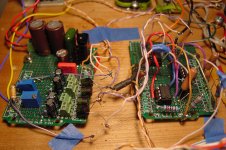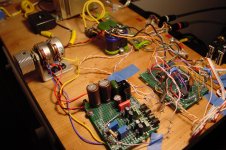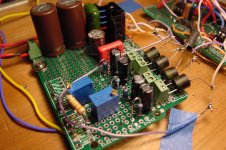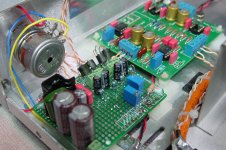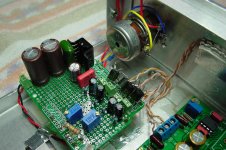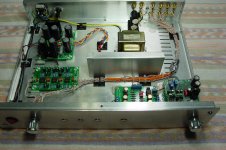Tony
Put bigger caps on your psu and put ~100uf and a small film or ceramic on legs of each ldr. This will help.
Thanks for reply. Next logical step was to increase size of caps. Do you have a ball park figure in mind, I am wary of too much since I don't want to slow p.r.a.t.
And I take on board your suggestion of caps across the ldr's.
Another question.
Since this Lightspeed is so sensitive to power supply, and I can't understand why since it seems independent of output side, then it is also possible that the pots and dropper resistors used will also contribute, or not, to SQ.
I love this thing, its easy to work on and a joy to use.
do not load the LDR side with capacitors.
It's the LED side that can benefit from capacitive filtering of the currents being fed into the LEDs.
It's the LED side that can benefit from capacitive filtering of the currents being fed into the LEDs.
do not load the LDR side with capacitors.
It's the LED side that can benefit from capacitive filtering of the currents being fed into the LEDs.
Thx Andrew, my bad, but across led feed side is what I meant.
Nothing to do with PRAT as the caps are on the LED side and that is isolated from the resistor side. Somehow, maybe capacitive coupling inside LDR shell, noise from the supply can get into the signal. So, make the supply quiet. The caps right at the LED side of the LDR help a lot and you can do this easily to your lightspeed. Be careful and dont solder for very long on the LED leads. The LEDs can change characteristics if they get to much heat and then they wont match anymore. Maybe you have some power inlet to your LDR board. Put caps there if you worry about putting them right on LED side. They wont do as much but they will still help a lot.
Nothing to do with PRAT as the caps are on the LED side and that is isolated from the resistor side. Somehow, maybe capacitive coupling inside LDR shell, noise from the supply can get into the signal. So, make the supply quiet. The caps right at the LED side of the LDR help a lot and you can do this easily to your lightspeed. Be careful and dont solder for very long on the LED leads. The LEDs can change characteristics if they get to much heat and then they wont match anymore. Maybe you have some power inlet to your LDR board. Put caps there if you worry about putting them right on LED side. They wont do as much but they will still help a lot.
Thx again, will be careful with heat may be try 0.1" away from leg so not to solder direct.(next hole)
Still puzzled though by 'caps are isolated from resistor side' when their effect is clearly audible.
Finally after it would seem way too many tries, I have balanced channels. Even though I bought the sorted LDRs, they were quite off from each other. I had to use a 330K resistor in front of the signal LDRs LED power supply to bring things down to a usable audio level. There was just too much gain too early. Also, a 100K Bourns pot was necessary to bring the loud channel even--though little of the 100K is being used, but much more than 1K. This is even after matching the LDRs as close as possible.
Wow! The outcome is amazing. I have been listening and unable to turn it off. All kinds of new layers come through that I have never heard before. Not all are music. Some are spatial. Peter Frampton Live "Do you feel like we do" sounded like you were in the arena yourself. The electronic solo floated in the center.
Thanks George for such innovation, it has great returns for those that try it.
Here is the breadboard, you see the evidence of many trials. A proper case and clean up is coming.
Wow! The outcome is amazing. I have been listening and unable to turn it off. All kinds of new layers come through that I have never heard before. Not all are music. Some are spatial. Peter Frampton Live "Do you feel like we do" sounded like you were in the arena yourself. The electronic solo floated in the center.
Thanks George for such innovation, it has great returns for those that try it.
Here is the breadboard, you see the evidence of many trials. A proper case and clean up is coming.
Attachments
Wow!! looks like you've been having fun with those pics. Thanks for the praise.
Cheers George
Cheers George
I'm just trawling through topics at the moment before building an LDR attenuator, so it's only fair to point out that I've no build experience with these.
However, I noticed the discussion regarding power supplies and wondered if this would be useful. 1.0uV Ultralow noise DAC power supply regulator 3.3V 5.0V 800mA - DIYINHK
I'm using one to good effect as a USB power supply for a Geek Out 720 DAC. I appreciate that the Teradak USB PSU may work out as cheap, but I've not tried one, so don't know how it compares.
However, I noticed the discussion regarding power supplies and wondered if this would be useful. 1.0uV Ultralow noise DAC power supply regulator 3.3V 5.0V 800mA - DIYINHK
I'm using one to good effect as a USB power supply for a Geek Out 720 DAC. I appreciate that the Teradak USB PSU may work out as cheap, but I've not tried one, so don't know how it compares.
Anything is worth a try, I've had Lithium Ion battery on them and it's a brave man that can say he could pick the difference in a "blind" A/B between it and the linear wall wart with well made 7805 based regulated supply.
Cheers George
Cheers George
Just to let all know.
When measuring the noise on the output of the Lightspeed Attenuator built as I have outlined.
With a shorted input (which is how to measure noise) I got a noise measurement on the Lightspeed's output of 200uV!!! (not mV) which is almost the base line of my Tektronix scope, and most likely the Tek's lead noise.
This amount of noise was measured with a linear transformer and 7508 regulator circuit powering the Lightspeed, and is far, far lower than any active preamp I have ever measured, which are always in the many mV region
Cheers George
When measuring the noise on the output of the Lightspeed Attenuator built as I have outlined.
With a shorted input (which is how to measure noise) I got a noise measurement on the Lightspeed's output of 200uV!!! (not mV) which is almost the base line of my Tektronix scope, and most likely the Tek's lead noise.
This amount of noise was measured with a linear transformer and 7508 regulator circuit powering the Lightspeed, and is far, far lower than any active preamp I have ever measured, which are always in the many mV region
Cheers George
Last edited:
Well, this is not an active preamp, but a passive one.
Have you compared it with the noise of a simple log pot, like an Alps or Noble?
Have you compared it with the noise of a simple log pot, like an Alps or Noble?
my passive and active pre-amps give a Hum + Noise reading of 0.0mVac on a 2000 count DMM.
This is equivalent to stating the H+N is <0.05mVac i.e. <50uVac
A suggestion that 200uV!!! is
This is equivalent to stating the H+N is <0.05mVac i.e. <50uVac
A suggestion that 200uV!!! is
indicates crap gear, or bad measurements, or simply exaggerating.far lower than any active preamp I have ever measured, which are always in the many mV region
Anything is worth a try, I've had Lithium Ion battery on them and it's a brave man that can say he could pick the difference in a "blind" A/B between it and the linear wall wart with well made 7805 based regulated supply.
Cheers George
Well George I for one believe you. Have spent several hours now refining a simple 7805 reg circuit after a 12v linear wall wart.
I found that the cap size(uf) on the input to the 7805 was critical, too much and the music somehow lost its speed and vibrancy, too little and it became hard and bright. The smaller bypass cap(around 100nf) was also critical for SQ.
I also found the output cap was even more critical with much the same effect as the input caps. Again the choice of bypass cap was critical.
I concede I don't have golden ears just normal pink ones but even they heard a distinct improvement, and not subtle.All this with reference to previous smps of course.
These are ones I have measured, and yes my Tek gear is not the latest and greatest as I said it was most probably the lead noise I was measuring.
But by all means Andrew sift through Stereophiles data bank of tests on active preamps
and show links of which ones have measured better than say 500uV of output noise.
Cheers George
But by all means Andrew sift through Stereophiles data bank of tests on active preamps
and show links of which ones have measured better than say 500uV of output noise.
Cheers George
I found that the cap size(uf) on the input to the 7805 was critical, too much and the music somehow lost its speed and vibrancy, too little and it became hard and bright. The smaller bypass cap(around 100nf) was also critical for SQ.
I also found the output cap was even more critical with much the same effect as the input caps. Again the choice of bypass cap was critical.
The caps really do matter and yet zero connection to the signal.
Member
Joined 2009
Paid Member
I wonder if, in principle at least, using separate LED and photosensitive resistor with some physical separation would ameliorate the power supply sensitivity ?
Maybe the LEDs flicker unless we put enough caps on them. Maybe the psu noise couples via capacitive coupling inside the LDR. I dunno. I know that some folks have tried your idea Bigun and I think they found them to also sound very good, but unsure about the psu noise problem. The problem with the other style LDR is that they dont go very low in resistance. The lowest one I've played around with was very large and I couldnt get it lower than 600 ohms.
Pass DIY Addict
Joined 2000
Paid Member
I found that the cap size(uf) on the input to the 7805 was critical, too much and the music somehow lost its speed and vibrancy, too little and it became hard and bright. The smaller bypass cap(around 100nf) was also critical for SQ.
I also found the output cap was even more critical with much the same effect as the input caps. Again the choice of bypass cap was critical.
Tony, don't be such a tease... 😉 What pre and post caps values did you settle on for the 7805 regulator?
I'm using a version of Salas' shunt regulator (picked up the board from Oliver) to power my DCB1 that uses LDRs.
Last edited:
I did not want to leave you thinking that the piece of scrap board pictured earlier was worthy of the the Lightspeed, so here is it in its pre and chassis. An LME49720 op amp based preamplifier with OPA 2134 phono stage. 100K pot from military electronic surplus in Florida. Very stout and precise.
As for the caps discussion, .33 uF at the entry of the 7805 regulator, .1 uF at the output of the reg. and 220 uF elna Silmics at entry, and 100 uF after, then 10 uF at the legs of the LEDs. Voltage to LDR system 4.94 VDC.
You can see this in the picture. How does it sound? I don't have the audiophile lingo to describe how good it is...absolutely zero background noise. There is extra bass to boot, wonderful.
Thanks again for the info.
As for the caps discussion, .33 uF at the entry of the 7805 regulator, .1 uF at the output of the reg. and 220 uF elna Silmics at entry, and 100 uF after, then 10 uF at the legs of the LEDs. Voltage to LDR system 4.94 VDC.
You can see this in the picture. How does it sound? I don't have the audiophile lingo to describe how good it is...absolutely zero background noise. There is extra bass to boot, wonderful.
Thanks again for the info.
Attachments
Last edited:
- Home
- Source & Line
- Analog Line Level
- Lightspeed Attenuator a new passive preamp
